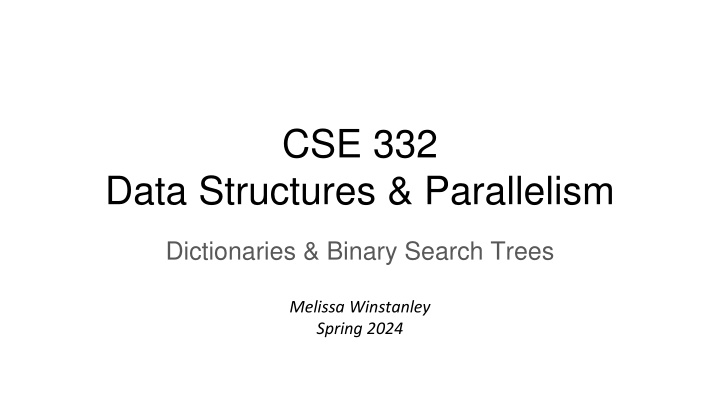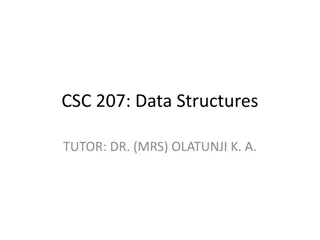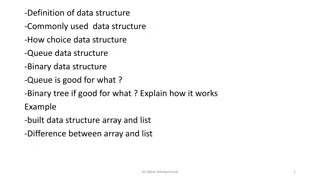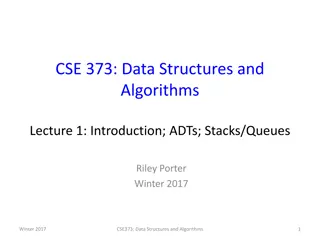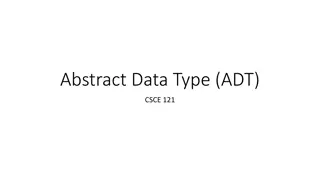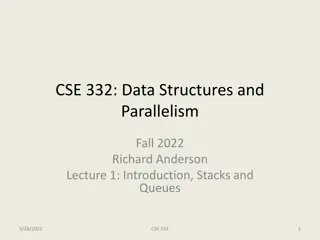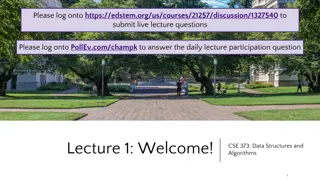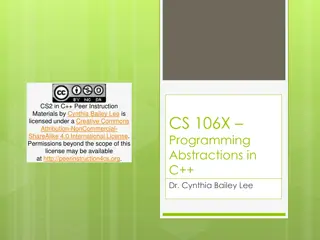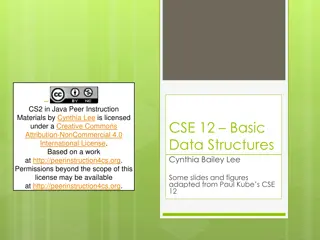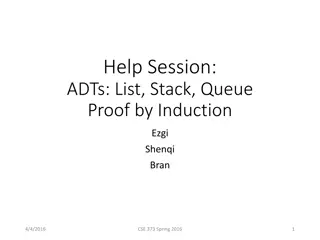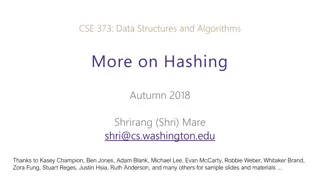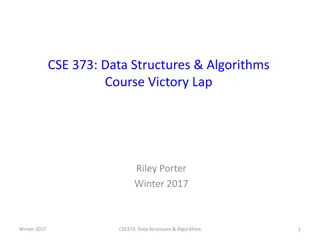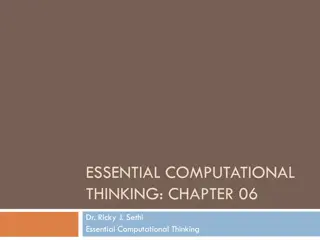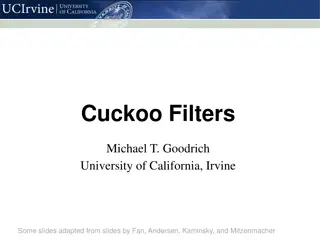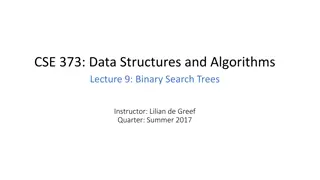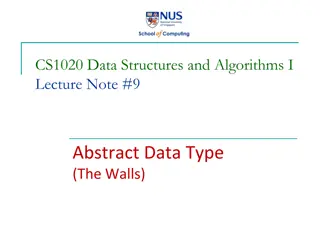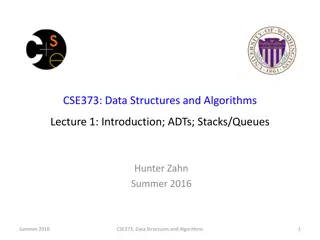Studying Data Structures and ADTs in CSE
Today in CSE 332, we delve into the essential ADTs of computer science and classic data structures like Stacks, Queues, Priority Queues, and Dictionaries. Understand how Dictionaries, also known as Maps, associate keys with values and learn about their operations like find, insert, and delete. Compare Set ADT with Dictionary ADT and explore the various use cases for dictionaries in networks, operating systems, compilers, biology, and more. Discover simple implementations using data structures such as unsorted linked lists, arrays, and sorted data structures like Binary Search Trees (BST).
Download Presentation

Please find below an Image/Link to download the presentation.
The content on the website is provided AS IS for your information and personal use only. It may not be sold, licensed, or shared on other websites without obtaining consent from the author.If you encounter any issues during the download, it is possible that the publisher has removed the file from their server.
You are allowed to download the files provided on this website for personal or commercial use, subject to the condition that they are used lawfully. All files are the property of their respective owners.
The content on the website is provided AS IS for your information and personal use only. It may not be sold, licensed, or shared on other websites without obtaining consent from the author.
E N D
Presentation Transcript
CSE 332 Data Structures & Parallelism Dictionaries & Binary Search Trees Melissa Winstanley Spring 2024
Where we are Studying the absolutely essential ADTs of computer science and classic data structures for implementing them ADTs so far: 1. Stack: 2. Queue: 3. Priority queue: push, pop, isEmpty, enqueue, dequeue, isEmpty, insert, deleteMin, Next: 1. Dictionary (a.k.a. Map): associate keys with values - Probably the most common, way more than priority queue
Today Dictionaries Trees
The Dictionary (aka Map) ADT Data: set of (key, value) pairs keys must be comparable (for some implementations) insert(mwinst, green) mwinst: green Operations: find(crajas) ... insert(key,val) places (key,val) in map (If key already used, overwrites existing entry) find(key) returns val associated with key delete(key) red crajas: red
Comparison: Set ADT vs. Dictionary ADT The Set ADT is like a Dictionary without any values A key is present or not (no repeats) For find, insert, delete, there is little difference In dictionary, values are just along for the ride So same data-structure ideas work for dictionaries and sets Java HashSet implemented using a HashMap, for instance Set ADT may have other important operations union, intersection, is_subset, etc. Notice these are binary operators on sets We will want different data structures to implement these operators
A Modest Few Uses for Dictionaries Any time you want to store information according to some key and be able to retrieve it efficiently a dictionary is the ADT to use! - Lots of programs do that! Networks: Operating systems: Compilers: Databases: Search: Biology: ... router tables page tables symbol tables dictionaries with other nice properties inverted indexes, phone directories, genome maps
Simple implementations For dictionary with n key/value pairs insert find delete Unsorted linked list Unsorted array Sorted linked list Sorted array We ll see a Binary Search Tree (BST) probably does better, but not in the worst case unless we keep it balanced
Lazy Deletion (e.g. in a sorted array) 10 12 24 30 41 42 44 45 50 A general technique for making delete as fast as find: Instead of actually removing the item just mark it deleted No need to shift values, etc. Minuses: Plusses: Simpler Can do removals later in batches If re-added soon thereafter, just unmark the deletion Extra space for the is-it-deleted flag Deleted nodes waste space find O(log m) time where m is data- structure size (m >= n) May complicate other operations
Better Dictionary data structures Will spend the next several lectures looking at dictionaries with three different data structures: 1. AVL trees - 1. B-Trees - - 1. Hashtables - Not tree-like at all Binary search trees with guaranteed balancing Also always balanced, but different and shallower B!=Binary; B-Trees generally have large branching factor Skipping: Other balanced trees (red-black, splay)
Why Trees? Trees offer speed ups because of their branching factors Binary Search Trees are structured forms of binary search
Binary Search Tree find(4)
Why Trees? Trees offer speed ups because of their branching factors Binary Search Trees are structured forms of binary search Even a basic BST is fairly good Insert Find Delete Worst-Case O(n) O(n) O(n) Average-Case O(log n) O(log n) O(log n)
Binary Trees Binary tree is empty or a root (with data) a left subtree (maybe empty) a right subtree (maybe empty) Representation: Data Left Not always pointers! Right pointer pointer For a dictionary, data will include a key and a value
Binary Tree: Some Numbers Recall: height of a tree = longest path from root to leaf (count # of edges) For binary tree of height h: max # of leaves: max # of nodes: min # of leaves: min # of nodes:
Calculating height What is the height of a tree with root root? int treeHeight(Node root) { ??? }
Calculating height What is the height of a tree with root root? int treeHeight(Node root) { if(root == null) return -1 return 1 + max(treeHeight(root.left), treeHeight(root.right)) } Running time for n nodes: O(n) (each node is visited once) Note: non-recursive is painful - need your own stack of pending nodes. Much easier to use recursion
Tree Traversals A traversal is an order for visiting all the nodes of a tree + Pre-order: root, left subtree, right subtree 5 * In-order: left subtree, root, right subtree 2 4 Post-order: left subtree, right subtree, root
More on traversals int inOrderTraverse(Node t) { if(t != null) { traverse(t.left); process(t.element); traverse(t.right); } } Sometimes order doesn t matter Example: sum all elements Sometimes order matters Example: print tree with parent above indented children (pre- order) Example: evaluate an expression tree (post-order)
Binary Search Tree 8 Structural property ( binary ) each node has 2 children result: keeps operations simple Order property all keys in left subtree smaller than node s key all keys in right subtree larger than node s key result: easy to find any given key 11 5 20 2 6 14 21 12 15 No duplicates this time!
Are these BSTs? 8 5 5 11 8 4 10 18 2 6 7 7 11 1 15 20 4 3 21
Find in BST, Recursive 8 Data find(Key key, Node root) { if(root == null) return null; if(key < root.key) return find(key,root.left); if(key > root.key) return find(key,root.right); return root.data; } 11 5 20 2 6 14 21 12 15
Find in BST, Iterative Data find(Key key, Node root) { while(root != null && root.key != key) { if(key < root.key) root = root.left; else root = root.right; } if(root == null) return null; return root.data; } 8 11 5 20 2 6 14 21 12 15
Other finding operations Find minimum node 8 11 5 20 2 6 Find maximum node 14 21 12 15
Insert in BST insert(10) 8 insert(7) 11 5 insert(31) 20 2 6 (New) insertions happen only at leaves - easy! 14 21 1. Find 2. Create a new node 13 15
Deletion in BST Why might deletion be harder than insertion? 8 11 5 20 2 6 14 21 13 15
Deletion Removing an item disrupts the tree structure Basic idea: find the node to be removed Remove it fix the tree so that it is still a binary search tree Three cases: node has no children (leaf) node has one child node has two children
Deletion - The Leaf Case 8 delete(13) 11 5 20 2 6 14 21 13 15
Deletion - The One Child Case 8 delete(11) 11 5 20 2 6 14 21 15
Deletion - The Two Child Case 8 delete(20) 5 20 What can we replace 20 with? 14 21 2 6 15
Deletion The Two Child Case Idea: Replace the deleted node with a value guaranteed to be between the two child subtrees. Options: successor from right subtree: findMin(node.right) predecessor findMax(node.left) These are the easy cases of predecessor/successor from left subtree: Now delete the original node containing successor or predecessor
Deletion Using Successor 8 8 5 5 20 21 14 21 14 2 6 2 6 15 15 findMin(right sub tree) --> 21 delete(20)
Deletion Using Predecessor 8 8 5 5 20 15 21 14 21 14 2 6 2 6 15 findMax(left sub tree) --> 15 delete(20)
buildTree for BST We had buildHeap, so let s consider buildTree Insert keys 1, 2, 3, 4, 5, 6, 7, 8, 9 into an empty BST If inserted in given order, what is the tree? What big-O runtime for this kind of sorted input? Is inserting in the reverse order any better? 1 2 3
Balanced BST Observation: BST: the shallower the better! For a BST with n nodes inserted in arbitrary order Average height is O(log n) see text for proof Worst case height is O(n) Simple cases such as inserting in key order lead to the worst-case scenario Solution: Require a Balance Condition that 1. ensures depth is always O(log n) 2. is easy to maintain strong enough! not too strong!
